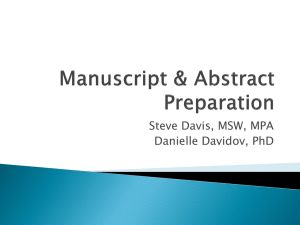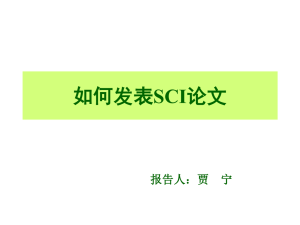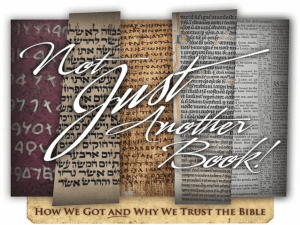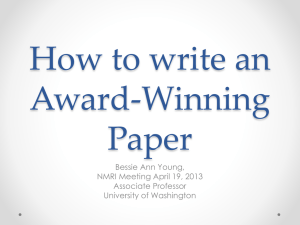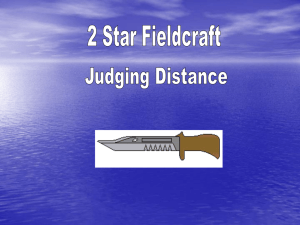5 - Taylor - SDM 2012 Student Paper Awards
advertisement
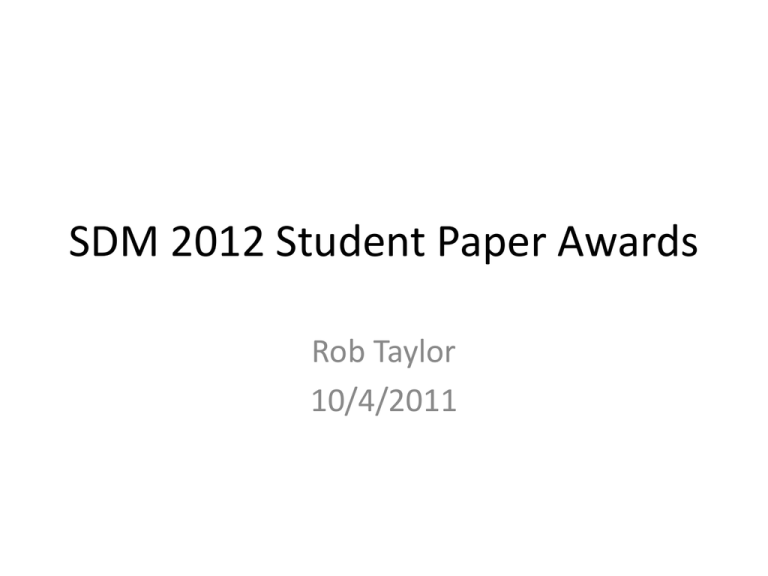
SDM 2012 Student Paper Awards Rob Taylor 10/4/2011 Student Awards Process for SDM (Long Range Planning Requirements) • • • • • • • Student papers can be scheduled throughout the entire week of the conference (M - Th). First round of the contest will be based on the manuscripts. All the student paper manuscripts will be evaluated using predetermined criteria to be provided by Student Paper Chair to a panel of judges representing all the TCs and co-located conferences. This review of the manuscripts will be the responsibility of the panel of judges and will be coordinated by Student Paper Chair. Based on the manuscript ratings for all the student manuscripts, the Student Paper Chair will down select the Top 6 manuscripts for the second round of the contest. The second round of the contest will consist of judging the actual presentations of the students. The Student Paper Chair will provide the judging criteria. The Student Paper Chair will assemble a panel of judges for the Top 6 paper presentations. Top 6 student papers will be judged in a special evening (recommended Tuesday, but could be Sunday or Monday, to the discretion of the SDM Organizing Committee) judging session. This session is expected to run for 3.5 – 4 hours. Student Awards Process for SDM (Long Range Planning Requirements) • The SDM Student Paper Chair is only responsible for selecting the Jefferson Goblet and the American Society for Composite (ASC) student paper award winners. • The 6 finalists based on manuscripts will include at least 2 composite material or composite structures related papers. • The highest ranked paper based on manuscript and presentation will receive the Jefferson Goblet Award. • The highest ranked composite related paper will receive the ASC student paper award. If the Jefferson Goblet award is given to a composite related paper, the second ranked composite related paper will receive the ASC award. • The names of the Jefferson Goblet and ASC awardees will be shared with the Structures TC. The Structures TC will be responsible for selecting the Lockheed Martin and Hilton award winners. The winners of the Jefferson Goblet and ASC awards will be excluded from receiving the Structures TC sponsored student paper awards. Time Line for Student Paper Competition • • • • • • • • • • • • • • • 24 Aug – Student Paper Chair Sends draft judging criteria to SDM planning committee 7 Sep - SDM planning committee finalizes judging criteria 15 Oct – Chairs provide list of all student papers to SDM Student Paper Chair. 25 Oct – Send manuscript judging criteria to authors. 10 Jan – Contact TC reps and conference chairs for list of manuscript reviewers. 28 Feb – Manuscript reviewer assignments complete. 1 Mar - Send oral presentation judging criteria to authors. 7 Mar - Contact TC reps and conference chairs for list of presentation reviewers. 30 Mar – Notify students that have not submitted manuscript that they have until 2 Apr to submit manuscript. 2 Apr – Student manuscript deadline 3 Apr – Contact delinquent students to inform them that their paper has been withdrawn from student competition. 9 Apr - Manuscript reviews complete, TC/conference reps give rankings to student papers chair 11 Apr - Telecon to downselect 6 finalists 12 APR – Student papers chair notifies all students of status Apr [TBD: 23,24] - Student presentation session at SDM Conference Notes • Technical content evaluated during the manuscript judging – Presentation evaluation focuses on effectiveness of communication • TC's score their own papers, provide results to SPTC for compilation. – Accept variation that will occur across reviewers and committees—necessary in order to have manuscript technical content reviewed by subject matter experts • Only composites papers in top six manuscripts eligible for the Jefferson Goblet Award – In the event that there are not 2 composites papers in the top six manuscripts, the ASC composites award will be determined by ASC in a separate presentation session—SPTC to contact ASC about this contingency • Special judging session for the top six papers will occur Tuesday evening – Time and location TBD when final program printed in order to take advantage of early room availability if there are paper withdrawals from the regular Tuesday afternoon sessions—5:30 start time is preferred if possible • • • Short version of manuscript judging criteria will be used Presentations will be scored only at the top level criteria (Slide 7) with an overweighting on presentation style Session organizers should not schedule any student papers late in sessions on Tuesday afternoon in order to avoid conflict with the student judging session. Past Manuscript Judging Criteria Short Form Evaluation Criteria (a) 1. Originality 2. Technical Content & Quality 3. Relevance of Contribution 4. Organization and Clarity TOTAL Points Raw score by evaluator (b) ______ (Max. 10) ______ (Max. 10) ______ (Max. 10) ______ (Max .10) _____ (Max. 40) Weight (c) 2.0 3.5 1.5 2.0 -------- Weighted Points (d) = (b)x(c) ________ (Max. 25) ________ (Max. 35) ________ (Max. 15) ________ (Max. 25) ________ (Max 100) Past Oral Presentation Judging Criteria INTRODUCTION: ……………………………….………………………..……(20 points max) ___________ The research question/hypothesis was clearly stated The goals and specific objectives were presented The project had sufficient, supporting background METHODS & RESULTS ……………………………….……………….………(20 points max) ___________ The methods were clearly outlined/explained The presenter acknowledged limitations to the study The results were clearly explained and significant results were highlighted CONCLUSIONS ……………………………….………………………..………(20 points max) ___________ A review/summary of the project was presented The significance of the results was discussed The applicability of the results was discussed PRESENTATION STYLE ……………………………….………………………(40 points max) ___________ Presentation aids were clear and readable Presentation was well-structured and logical Presentation fit into the allotted time The student seemed knowledgeable The student exhibited appropriate voice projection, eye contact, confidence, and reliance on notes The student responded well to questions from the audience Past Manuscript Judging Criteria Extended Form • Technical Content (15 points) • • • Clear statement of fundamental principles used (5 points) Clear statements of justification for approximations and assumptions used (5 points) Reviewer's choice (5 points) • Importance to the Field (15 points) • • • Statement of where work fits in to state of the art (5 points) Statement of what is enabled or can be now accomplished as a result of this research (5 points) Reviewer's choice (5 points) • Style and Clarity (15 points) • • • Effective use of sections and subsections and appropriate heading titles (5 points) Effective use of figures, plots, tables, including labeling, legends, line styles, color, and consistency of legends, line styles, and colors from figure to figure (5 points) Conciseness (5 points) • Completeness (15 points) • • • • Review of state of the art (3 points) Clear statement of objectives (4 points) Clear statement of approach (4 points) Clear statement of conclusions supported by findings (4 points)
